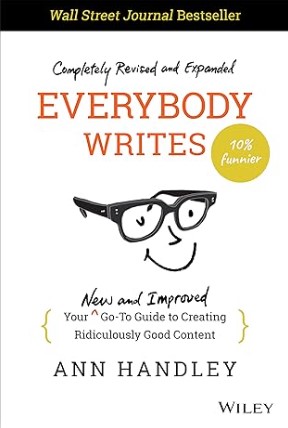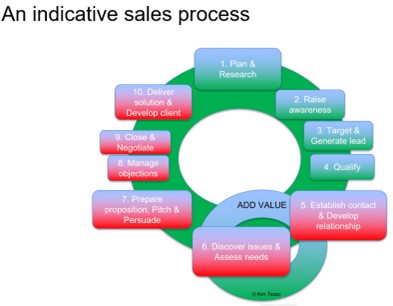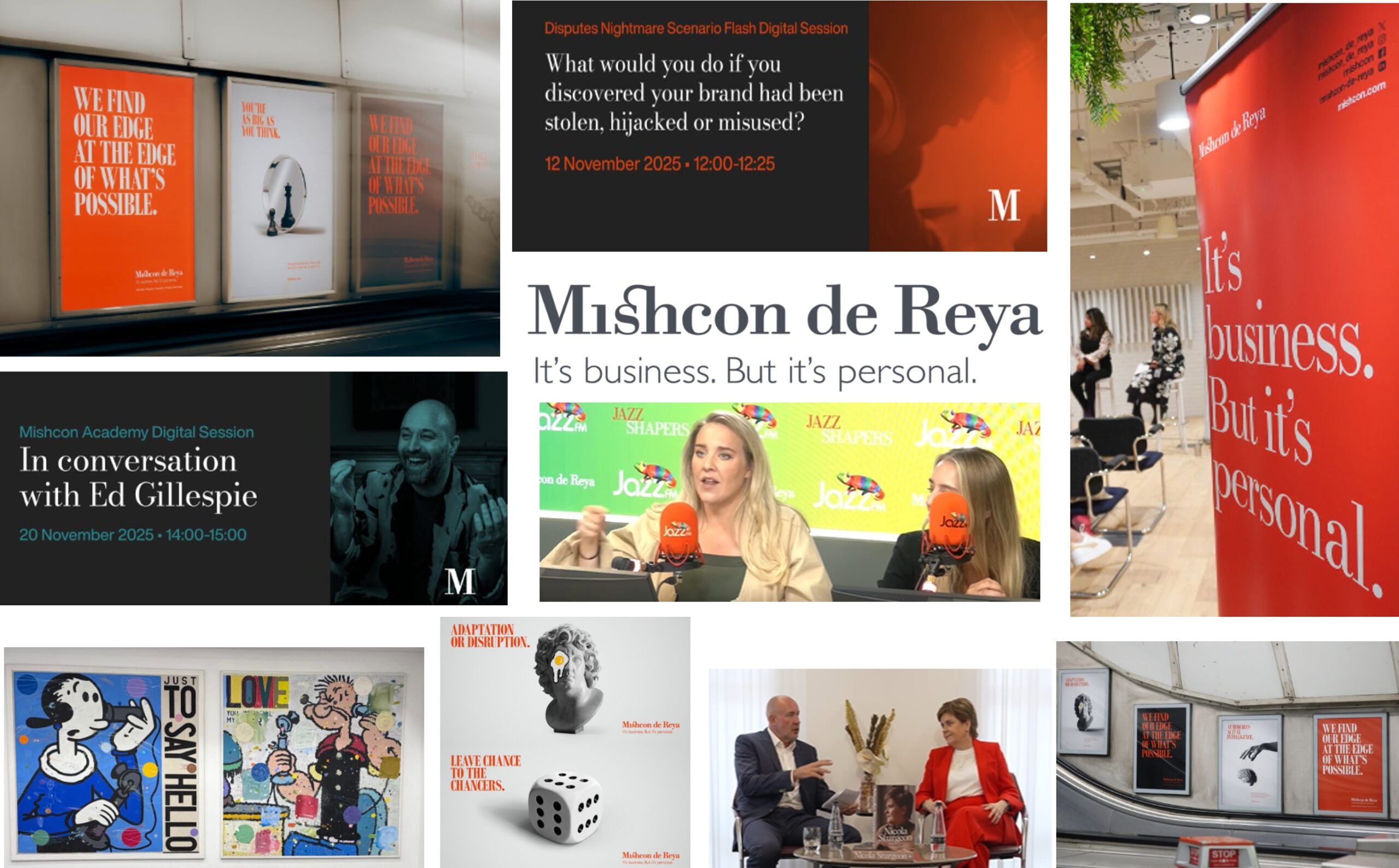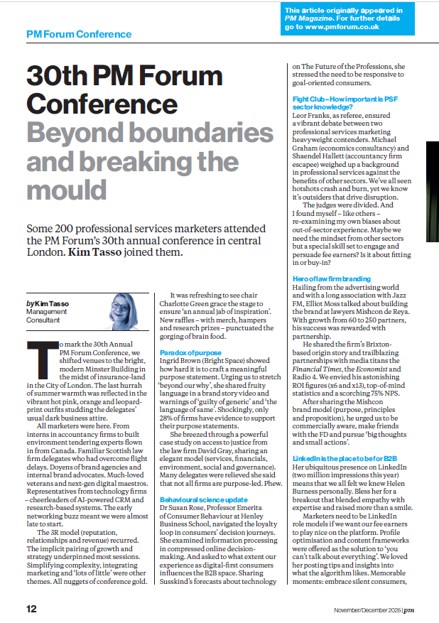
I’m always searching for great books to recommend to people who attend my training courses. My previously recommended books on writing are still good and amongst my “go tos”. But I wanted an up-to-date recommendation on a writing book. I recently researched top marketing books and – surprise – this one is amongst them. So it meets the needs of marketers (including those in B2B) facing a variety of writing challenges. And it’s a Wall Street Journal bestseller. Book review: Everybody writes by Ann Handley.
Overview of Everybody writes
The book has an impressive list of accolades – including from Seth Godin and an array of leading businesspeople, mainstream writers, marketing and brand leaders, creatives, content marketing experts and academics. But prepare yourself if you are not American for a few inevitable style irritants.
Everybody Writes has a subtitle “Your new and improved go-to guide to creating ridiculously good content”. It’s a long book at 390 pages but it’s well-structured, with bite-sized chapters and a relatively easy read that’s written in a conversational style. It’s funny too.
- Part One: Writing rules: how to write better (and how to hate writing less) – 32 chapters
- Part Two: Writing rules: grammar and usage – 22 chapters
- Part Three: Voice rules – 10 chapters
- Part Four: Story rules – five chapters
- Part Five: Publishing rules – 14 chapters
- Part Six: 20 things marketers write – 19 chapters
- Part Seven: Content tools (20 pages)
As I was reading the book I frequently stopped and had a go at applying ideas to my various writing tasks. So it provides practical advice, inspiration and motivation.
Author Ann Handley
Ann Handley is a Wall Street Journal best-selling author whose work has appeared in many media including The Financial Times. IBM named her one of seven people shaping modern marketing. She’s the world’s first Chief Content Officer, a principal at training and education company MarketingProfs and a speaker at events globally.
She’s a mom and a dog person too. Her favourite book of all time is E B White’s “Charlotte’s Web” and she acknowledges “The elements of style” by Strunk and White as a continuing guide (admiration here as it’s a book that I can’t say I got on with),
What I love about “Everybody writes”
Things I love about this book “Everybody writes”:
- The author’s conviction that everyone can write well (“part habit, part knowledge and part giving a d***”)
- The sense of connection with a real, human writer – it feels like a conversation
- I smiled at her writing – it’s genuinely funny
- It’s written for marketing professionals so really focused on our needs (“better writing and better marketing”) but embeds good journalism, legal (although it refers to US law) and ethical practice
- 91 short, bite-sized chapters – which you are invited to read by “choosing your adventure”
- The author is a master storyteller – so it’s interesting and easy read as well as educational
- The writing process is explored
- It’s up to date (revised in 2023)
- It tackles general principles of great writing (including the process) and then delves into (20) specifics like of what marketers have to write
- It’s stuffed full of great strategies, frameworks and practical ideas to help you improve your writing (e.g. Fifteen ways to organise a blog post or article)
- There are lots of ideas to cut surplus words and strengthen your writing – with multiple examples of adverts and emails before and after editing and curation
- It guides you on storytelling (see also Storytelling book reviews: The Story Advantage and The Story Factor (kimtasso.com))
- And pays particular attention to tone and voice
- The author offers no-nonsense answers (see, for example, Should you ungate your content? Should you speak out on social issues or causes? The new ideal length for every piece of content, why you need an email newsletter)
- There are a few professional service firm examples (for instance, a big 4 accountancy firm on gender discrimination)
- There’s 13 pages listing helpful tools (and yes, even AI tools). Whilst acknowledging the power of computers she argues “but no one can copy your voice”
The rare things I am less enthusiastic about in “Everybody writes”
- That conversational style. Whilst I adore her personality-filled and story-fuelled writing, the short, snappy style grates a bit after a while
A selection of the best ideas from “Everybody writes”
There are so many great ideas that I simply can’t give them all a mention. So instead I’ll pull out a few that resonated with me. So please read the book as you may mine different gems…
- For high quality content, follow the Formula of Three – Utility, Inspiration and Empathy (see my take on this Power of three – Writing and presentation basics (Video) (kimtasso.com)
- The writing GPS framework
GO
- Goal
- Ask “So what?”
- Add data
- Organize
PUSH
- First draft
- Walk away
- Second draft
- Rewrite to one person
- Add voice
- Headline
SHINE
- Robot edit
- Human edit
- Read it out loud
- Eyeball for scanners
- Publish (with a Call To Action – CTA)
- Let it go with love
- Reconcile your emotions
- Place the most important words at the beginning of each sentence
- Add sensory details – Not just what you see, but also anything you hear, smell, taste, touch, feel
- Track the number of words you write. Not how long it took to write them. Aim for 750 (about two pages of text) or 999 words a day
- Tone of voice isn’t what you say. It’s how you say it. It’s how your marketing channels and assets “talk” to a customer online. Nielsen Norman Group identified four primary dimensions to tone of voice: Funny vs serious, formal vs casual, respectful vs irreverent and enthusiastic vs matter-of-fact. A tone of voice chart shows: attribute, description, like this, not like this. Four powerful places to apply brand voice: microcopy, about us, first touch and last touch. Voice doesn’t change, tone does.
- The Rudolph framework. I learned the origin of this popular Christmas reindeer song. And the fill-in-the-blanks template for story writing is helpful. She adds that B2B storytelling works best when a human hero is at the centre.
- Hermit crab content is where you take an existing format and repurpose it in a new way (from Brenda Miller and Suzanne Paola).
- Ideas and data sources for monitoring memes and trends and then newsjacking (a term coined by David Meerman and there’s a diagram of the life of a news story)
- Multiple tips and nonobvious techniques to hone your interviewing skills (especially “converse, don’t interview” and “laser listening”)
- The practical advice on writing a home page, the about us page, landing pages, headlines, video, social media (including hash tags) and LinkedIn profiles
Stand out quotes from “Everybody writes”
- Writing matters more now, not less
- We are a planet of publishers, yet many of us are polluting the pool with content rubbish
- Our online words are our emissaries (Beth Dunn)
- Everything the light touches is content
- Learn the rules like a pro, so you can break them like an artist
- Writing is a habit, not an art
- There is no one way to write
- Creating The Ugly First Draft (TUFD)
- Good writing serves the reader, not the writer
- Develop pathological empathy (strive to explain)
- Think before ink
- Give special love to the first and last sentence of your piece (lede/lead and kicker in journalism terms)
- Show, don’t tell (this is one of my favourite sayings – she extends this to “tell me without telling me”)
- Be specific enough to be believable, and universal enough to be credible
- Metaphors are much more tenacious than facts (Paul de Man)
- Let white space give your text oxygen (a visitor to your web site reads only 28% of the words on a page – sometimes as little as 20%, according to a study by NN Group)
- Deadlines are the WD40 of writing
- Jargon and buzzwords are the chemical additives of content
- The simplest version of a word is the strongest version of a word
- Default to the present tense
- Adverbs aren’t necessary
- Your content is not about storytelling, it’s about telling a true story well (six elements of a compelling marketing story: it’s true, it’s human, it’s original, it makes your customer the hero, it makes people feel something, it’s aligned with a long-term business strategy)
- It’s what I call Messaging Karaoke, a bunch of companies singing the same exhausted words and tired phrases (accounting, law and consulting firms are highlighted here – some insights into good law firm content too)
- Invite multiple perspectives into your content
- Facts are the pillars of any good reporting (Jesse Noyes, a former reporter for the Boston Business Journal)
- (When interviewing) Embrace your ignorance and admit what you don’t know
- Try to avoid any business research older than four years
- For every $1 invested in email, there’s the potential for a $38 return
- Stop sounding like a marketer. Sound like a person
- The nature of LinkedIn has changed. In the past few years, LinkedIn has become less buttoned-up: Less skinny jean, more relaxed fit
- Change your mindset from “always be closing” to “always be helping”
- B2B is MORE emotional, not less
Other writing book reviews
Book review – Peter Frederick’s “Persuasive writing” (kimtasso.com)
Book review by Kim Tasso – Ian Atkinson’s Business writing
Book review: Digital Body Language – How to build trust by Erica Dhawan (kimtasso.com)
Storytelling book reviews: The Story Advantage and The Story Factor (kimtasso.com)
Social Media in Business Development and Relationship Management: Lawyers (kimtasso.com)
Book review “Valuable content marketing” by Jefferson and Tanton (kimtasso.com)
Book review of Hypnotic writing by Joe Vitale (kimtasso.com)
Related articles on writing skills
Persuasive writing checklist (kimtasso.com) February 2024
Persuasive writing – Mindset, audience, headlines, key points (kimtasso.com) October 2023
22 tips on being a persuasive writer in professional services (kimtasso.com) August 2023
Hooks, Headlines and Hard-Wired Words: 11 ideas for better writing (kimtasso.com) October 2022
Video – The art of storytelling – Kim Tasso explains April 2021
Power of three – Writing and presentation basics (Video) (kimtasso.com) December 2020
Seven secrets of great business writing (Video) VASTCOP (kimtasso.com) April 2020
The Legal PR Guide – Gaining buy-in to law firm media relations (kimtasso.com)
Writing tips for finding news stories, backstories and explainers (kimtasso.com) April 2019
Top persuasive writing tips – Audience, structure and content (kimtasso.com) February 2019
Persuasive writing – nine writing tips (kimtasso.com) October 2017
selling legal services with storytelling (kimtasso.com) September 2017
Persuasive writing tips – five technical questions (kimtasso.com) March 2017
Business development writing for lawyers (kimtasso.com) July 2016
5 favourite thoughts on business development writing (kimtasso.com) March 2015
top tips on marketing and business development writing (kimtasso.com) April 2014
How to write a press release – Kim Tasso June 2013
Feedback from an effective writing workshop (kimtasso.com) April 2012








